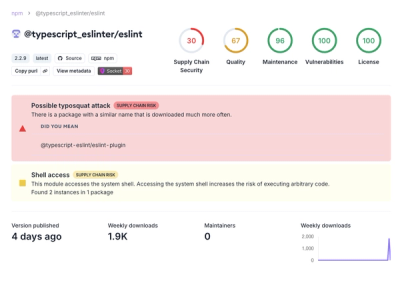
Security News
Research
Data Theft Repackaged: A Case Study in Malicious Wrapper Packages on npm
The Socket Research Team breaks down a malicious wrapper package that uses obfuscation to harvest credentials and exfiltrate sensitive data.
This Python module facilitates the creation of Sphinx Documentation directly from Jupyter Notebooks. Essentially, it provides a preconfigured environment that utilizes nbsphinx in the background, complete with custom styles and preloaded modules.
$ pip install -U dunderlab-docs
To generate Sphinx documentation, start with the sphinx-quickstart command. Then, in the Sphinx conf.py file, add 'sphinx' and dunderlab.docs to the extensions list.
extensions = [
'nbsphinx',
'dunderlab.docs',
]
dunderlab_custom_indexThis setting allows you to insert a custom ReStructuredText into the index.rst file. This custom index will be rendered following the main index and will also appear in the sidebar.
dunderlab_custom_index = f"""
.. toctree::
:glob:
:maxdepth: 2
:name: mastertoc3
:caption: Submodule 1
notebooks/submodule1/*
.. toctree::
:glob:
:maxdepth: 2
:name: mastertoc3
:caption: Submodule 2
notebooks/submodule2/*
"""
dunderlab_color_linksCustomize your documentation's appearance by altering the link colors. For instance, setting dunderlab_color_links to #4db6ac changes all links to a blue shade, adding a unique touch to your documentation. Remember, changes to the stylesheet impact the entire documentation, so test thoroughly before publishing.
dunderlab_color_links = '#4db6ac'
dunderlab_code_referenceThis configuration value can be used to disable the generation of certain index inputs in Sphinx documentation. Specifically, setting to True will enable the generation of the index inputs genindex, modindex, and search, while setting it to False will disable their generation.
dunderlab_code_reference = False
dunderlab_github_repositoryThis configuration specifies the project repository, which will be used to adjust the URLs of the images in the README.md file.
In the first build, for example make clean html, the system will create (if not yet exist) the folder notebooks with some files in it.
docs/
build/
source/
conf.py
index.rst
_modules/
_static/
_templates/
-> notebooks/
-> 01-getting_started.ipynb
-> readme.ipynb
-> __sandbox.ipynb
The readme.ipynb notebook is mandatory, as it generates the README.md file in the root of the Python package. Documentation notebooks should be named with numeric prefixes for sorting purposes. Notebooks named with __ prefixes won't be rendered into the documentation.
readme.ipynbThis notebook is used to generate the main documentation page, which is typically the index.rst file. The notebook is converted into a ReStructuredText file, which is then rendered as HTML to create the main documentation page. Additionally, the readme.ipynb notebook is also used to generate the README.md file that is typically found in the root of your project. This file can provide a brief overview of your project and its purpose, along with any relevant installation or usage instructions.
license.ipynbThis notebook is used to generate the LICENSE file that is typically found in the root of your project. This file specifies the terms under which your code is licensed and provides information about how others can use and modify your code. It is recommended that the license.ipynb notebook contain a single Markdown or plain text cell that includes the full text of your project's license. This can help ensure that the license text is accurate and up-to-date, and can simplify the process of updating the license if needed.
footer.ipynbThis notebook is used to generate a footer that appears at the bottom of the main documentation page and the project's README.md file. It can contain any content you want to include in the footer, such as copyright information, acknowledgments, or links to related resources. During the documentation build process, the notebook is converted into HTML and added to the bottom of the main documentation page and README.md file.
If the Index and Module Index appear empty:
Resolve this by adding the target module's path to the PATH variable in the conf.py file
import os
import sys
sys.path.insert(0, os.path.abspath('relative_path_to_module'))
If images aren't visible in the readmereadme.md file:
Verify their paths to ensure they're accessible from the GitHub repository. Relative paths must be correctly set relative to the README.md file's location.
The images used in the readme.ipynb notebook should be placed in a folder called _images.

FAQs
Unknown package
We found that dunderlab-docs demonstrated a healthy version release cadence and project activity because the last version was released less than a year ago. It has 1 open source maintainer collaborating on the project.
Did you know?

Socket for GitHub automatically highlights issues in each pull request and monitors the health of all your open source dependencies. Discover the contents of your packages and block harmful activity before you install or update your dependencies.

Security News
Research
The Socket Research Team breaks down a malicious wrapper package that uses obfuscation to harvest credentials and exfiltrate sensitive data.

Research
Security News
Attackers used a malicious npm package typosquatting a popular ESLint plugin to steal sensitive data, execute commands, and exploit developer systems.

Security News
The Ultralytics' PyPI Package was compromised four times in one weekend through GitHub Actions cache poisoning and failure to rotate previously compromised API tokens.